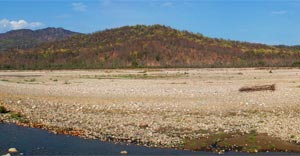For the survival of such a remarkable gamut of floral and faunal species in Jim Corbett National Park , water is a crucial factor. The Ramganga river forms the most prominent hydrological resource, supplemented by tributaries, most prominent of which are the Sonanadi, Mandal and Palain rivers. The river Kosi runs proximate to the Park and is also a significant water resource for nearby areas. Wildlife is dependent on rivers, more so in the dry season, for they provide drinking waters and also forms home to several key aquatic species.
Ramganga
Ramganga river is crucial for Corbett infact without it there would be no Corbett. It is the largest of the precious few perennial sources of water in the Park. A rain-fed river originating near Gairsain in the Lower Himalayas, the Ramganga traverses more than 100 km before entering Corbett near Marchula. Inside the Park it flows roughly 40 km till Kalagarh where it enters the plains. During this run through the Park it gathers waters from the Palain, Mandal and Sonanadi rivers.
The Ramganga is inhabited by key aquatic species like mahseer fish, the endangered gharials, mugger crocodiles, otters and turtles. Many species of birds, like kingfishers, fish-eagles, terns and storks depend on the Ramganga. During winters the Ramganga reservoir attracts many migratory bird species, especially waterbirds from Europe and Central Asia.
Kosi
The Kosi is a perennial river like the Ramganga and its catchment lies partially in Corbett NP. From Mohan through Dhikuli till Ramnagar, the Kosi forms the eastern boundary of Corbett National Park. Even though the Kosi does not enter the Park boundary, wild animals from Corbett use it for drinking especially during pinch periods. Its bed is strewn with boulders and its flow is erratic and often changes course. Kosi is notorious for its unpredictable and damaging torrents during monsoon. Like Ramganga, the Kosi too is inhabited by mahseer and attracts migratory birds.
Sonanadi
The Sonanadi is an important tributary of the Ramganga. Named after this river the Sonanadi Wildlife Sanctuary adjoins Corbett National Park and forms an important part of the Corbett Tiger Reserve. The Sonanadi enters the Park from the northwest direction and meets the Ramganga at the reservoir.
The name Sonanadi means river of gold. At one time grains of gold, found in the alluvial deposits washed down from the higher areas, were extracted from the bed sand by sieving, washing and mercury treatment.
Mandal and Palain
The Mandal rises in the eastern heights in Talla Salan in Chamoli district. Forming a part of the northeastern boundary, Mandal flows for 32 km and joins the Ramganga at Domunda a little distance above Gairal. During the dry season, the Mandal contains very little water but during the monsoons it turns into a furious torrent. It forms a vital breeding ground for the endangered mahseer. The Palain is the third important tributary of the Ramganga and enters the Park from a northern direction. It meets the Ramganga about 3 km north of the Ramganga reservoir.
Sots
Sot is the local name for a seasonal stream. While traveling across the park you may cross several of these bouldery dry streams. Though most of them appear dry and lifeless, they are very important for the Park ecology. Animals depend on these sots for their drinking water requirements for a good part of the year. There are some sots in Corbett that are perennial, important ones being Paterpani, Laldhang, Kothirao, Jhirna, Dhara and Garjia. Since water is a limiting factor, these perennial sots provide water to wildlife during pinch periods. Many of these sots are covered with thick growth of evergreen shrubs and bamboo clumps which form ideal shelter for many animals including the tiger.



